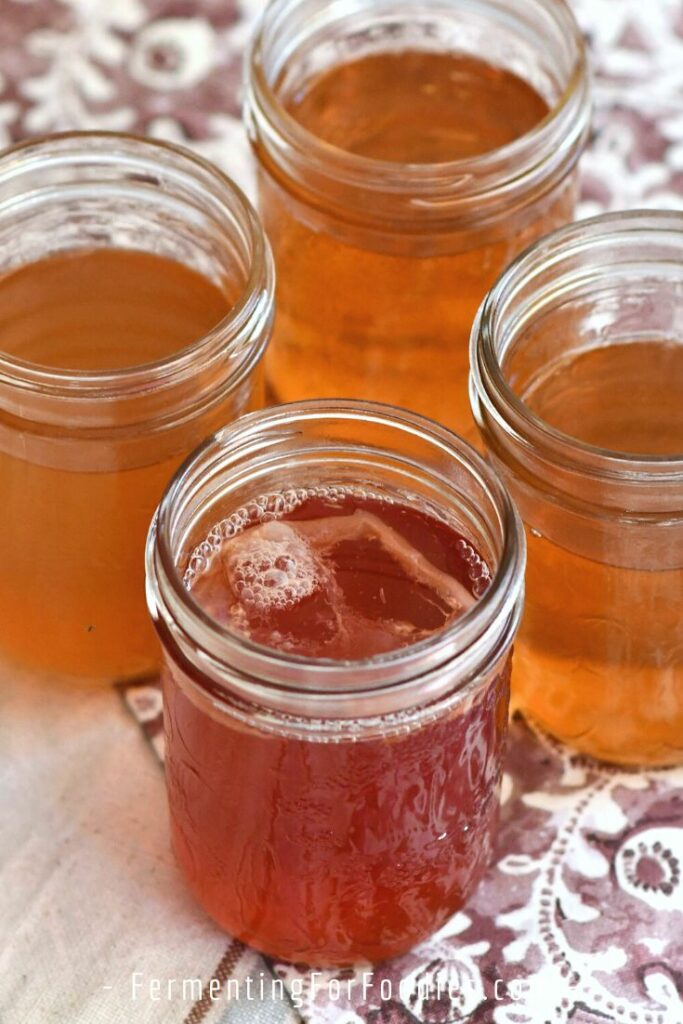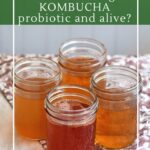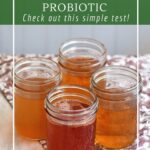Are you wondering if all store-bought kombucha is probiotic? Unfortunately, the vast majority of store-bought kombucha is probably not live or probiotic. There are no rules around probiotic and fermented claims on packaging. Just because something says “probiotic” on the label, doesn’t mean it actually is.

Here’s how to separate the marketing from the product.
Before I got into fermenting, I’ll admit that I enjoyed store-bought kombucha, thinking that it was a fun and healthy beverage. As it turns out, I would have been better off drinking water. Most brands of kombucha are fairly similar to soda pop: sweet, acidic, and not at all probiotic.
How to Tell if store-bought kombucha is probiotic
I’ll admit, I feel a bit uncomfortable stating that a particular brand of kombucha is not at all probiotic. Especially since most of them are branded as probiotic! There are some extremely fancy, expensive, gut-health-touting products that are as probiotic as a can of cola.
I usually hear about these products when a Fermenting For Foodies fan tries to use one of them as a culture for a ferment… and it doesn’t work. I feel awful telling someone that their $30 health ade is likely not probiotic because the brand freely admits on their website that their kombucha is a shelf-stable product.
As anyone who has ever fermented knows… anything that is live and probiotic is not shelf-stable.
Five Rules for Choosing Probiotic Brands
Luckily, once you know what you’re looking for, it’s pretty easy to separate the probiotics from the marketing.
- Don’t be fooled by marketing. It might claim to have 1 billion live bacteria, organic tea, and cold-pressed juice, but if it’s in a sealed container, then none of that matters. I imagine those claims are based on the product, prior to packaging.
- Real kombucha MUST be refrigerated at all times. Kombucha is bubbly because it contains yeast. The yeast will continue to ferment and carbonate unless it’s refrigerated. Any kombucha not stored in the fridge is either waiting to explode or it’s not live.
(Funny side story, a few years ago, I worked for a non-profit that turned reclaimed fruit into hard cider as a fundraiser. After about a month we had to pull all the unsold bottles out of the local liquor stores because they were exploding in people’s trunks! That’s what live fermented beverages will do!) - Probiotic kombucha will have a short best-before date: Kombucha will keep fermenting, even in the fridge. So expect a short best-before date (less than 1 month). However, that doesn’t mean it expires in a month… it will just be less sweet.
- Unpasteurized or wild: If you want something to be probiotic, make sure it’s not pasteurized. Being labeled as unpasteurized or wild means that the kombucha is live.
- Local is best: The best way to get kombucha is from a local brewer. Since live kombucha must be refrigerated at all times and has a short best-before date, it really can’t travel very far. Looking for a local brewer? Check out the Kombucha Brewers Association. There are brewers all over the world! (I’ll admit, they don’t have either of my local Kombucha Brewers, but it’s a place to start looking).
Brewing kombucha from store-bought kombucha
If you have live, probiotic kombucha, then you officially have a kombucha starter!
The kombucha SCOBY is actually the brewed drink, not the rubbery disc that floats on top of the kombucha. Though having a kombucha pellicle (disc) does make brewing easier, it’s not necessary.
To brew with store-bought kombucha, simply purchase a neutral-flavored unpasteurized kombucha. Then use it to brew a batch of kombucha using the usual method. It will probably take a bit longer to ferment and grow the pellicle than indicated in the recipe. Expect it to take between 4 to 7 days.
The live kombucha from the video above took 5 days to make a pellicle, but it was bubbling from day one. The three brands of kombucha that weren’t alive never bubbled.
Not sure about brewing your own soda? Here are some different kombucha soda flavors to inspire you. Kombucha is a really robust and happy culture. Once you get started, you’ll be amazed at how easy it is! Not to mention, affordable, zero-waste, and truly gut-healthy. No marketing claims necessary. 🙂


Hi Emillie…what is the one brand you say is alive? I am attempting to make a scoby from GT Gingerade Kombucha. I have read that this one works. TIA
I haven’t tried GT. I think it could work because it’s always refrigerated. However, I imagine they’ve slowed down the fermentation somehow, because otherwise, they would have issues with over-carbonation and bursting bottles. We have a lot of small, regional brands which are all great for culture. I think any brand that’s shipping nationally is probably not a very active culture. Good luck!
Thank you Emillie.
I’ve been a GT drinker for almost 20 years. It’s the real deal. I’ve used their plain and ginger to make my own starter/SCOBY. Their bottles have changed over the years, currently have plastic lids, the metal original lids would explode. They’ve also cut back on the organic “sugar” and are using part kiwi juice in most of their flavors. The original formula was fermented longer causing a higher alcohol content. They now have a different label for those, and you have to be 21+ to purchase. I’ve kept bottles in the refrigerator for as long as 6 months, no explosions, didn’t turn to vinegar or hard kombucha just less sweet.
Krystal, I can confirm that GT soda was not included in my trial. 😉 I really wanted to have failures, so I went with companies that I was pretty sure wouldn’t work. These are all shelf-stable brands. If the kombucha is displayed in a tower of cans in the middle of an aisle… then it’s probably not alive. Cheers!